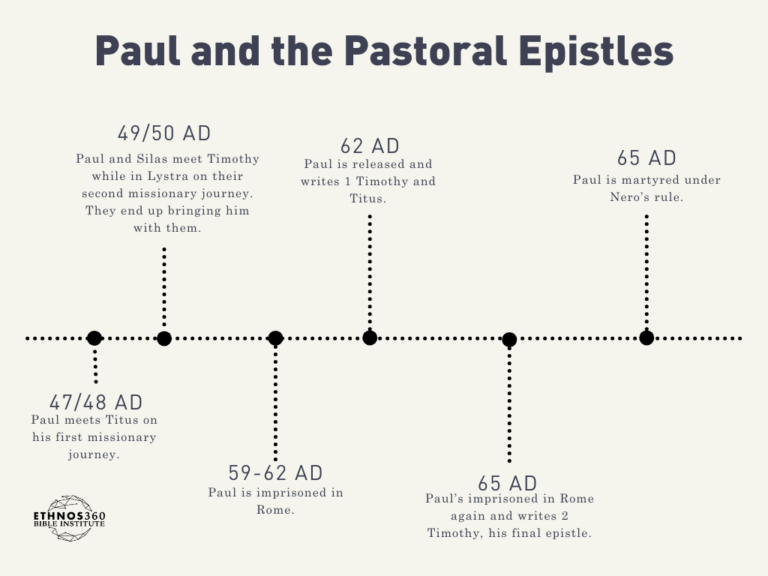
1 and 2 Timothy Overview
1 and 2 Timothy both have a personal feel to them because of the deep friendship between Paul and Timothy. These books and Titus are part of what are known as the Pastoral Epistles. At the time they were written, Timothy was shepherding a church in Ephesus, and in these letters, Paul gives him instruction regarding that role. 2 Timothy contains Paul’s final words. He wrote it while in prison leading up to his martyrdom. Being his final words, we know that the content of the letter is extremely important.

Timeline of Paul and the Pastoral Epistles
Literary Genre of 1 and 2 Timothy
Epistle (a letter written to someone)
Author of 1 and 2 Timothy
The author of these books is Paul, the apostle. Read more about Paul’s background and life here.
1 and 2 Timothy Audience
Paul wrote both of these epistles to Timothy, a young believer he met in Lystra while on his second missionary journey. Paul ended up bringing Timothy along with him and he became his closest disciple, his ‘son in the faith.’ Eventually he sent Timothy back to Ephesus. Paul had previously lived in Ephesus for two years and had sent the church there the epistle Ephesians. They already had established elders and Paul’s teaching, but the church was being threatened by people who were leading believers astray. Because of this, Paul thought the Ephesian church needed even more shepherding, and he decided Timothy was the man for the job. Timothy’s task was to help them become more independent.
Date 1 Timothy was Written
AD 62
Theme in 1 Timothy
How to Setup the Church to Withstand False Teaching
Key Verse of 1 Timothy
“’But as for you, O man of God, flee these things. Pursue righteousness, godliness, faith, love, steadfastness, gentleness. Fight the good fight of the faith. Take hold of the eternal life to which you were called and about which you made the good confession in the presence of many witnesses.”
1 Timothy 6:11-12
The Purpose of 1 Timothy
Paul’s purpose in writing 1 Timothy was to set up Timothy well for ministry with the Ephesian church. This letter would confirm to the Ephesians that Timothy was sent by Paul and that they should listen to Him. It also instructed Timothy on how to confront wrong teaching, put in place qualified leaders, and set an example. He really emphasizes the importance of focusing on the truth rather than rituals. He wants to make sure the purity of the Gospel is maintained. Another key to setting up the church well is making sure it has qualified leaders who will resist false teachers and defend the Gospel.
1 Timothy Outline
- 1:1-2 Greeting
- 1:3-4 Timothy’s Mission in Ephesus
- 1:5-11 Admonition
- 1:12-17 Paul’s Testimony
- 1:18-20 Paul Encourages Timothy to Stay the Course
- 2:1-5 Instructions on Prayer
- 2:6-7 A Responsibility of All Christians to Testify
- 2:8 Instructions on Prayer
- 2:9-15 Instruction for Women
- 3:1-7 Qualifications of Overseers
- 3:8-13 Qualifications for Deacons
- 3:14-16 Paul’s Desire to Visit Timothy
- 4:1-5 Some Will Depart from the Faith
- 4:6-16 Guidelines for the Good Servant
- 5:1-2 Relational Model of Ministry
- 5:3-16 Care for Widows
- 5:17-18 The Pastor’s Wage
- 5:19-22 Discipline of an Elder
- 5:23 The Sickness of Timothy
- 5:24-25 Covered Sins and Evidenced Works
- 6:1-2 Instructions for Servants
- 6:3-5 False Teachers and True Contentment
- 6:6-10 Eternal Perspective
- 6:11-14 Fight the Good Fight of Faith
- 6:15-16 The Assurance of the Good Minister is Christ
- 6:17-19 Exhortation to the Rich
- 6:20-21 Last Exhortation to Timothy
Date 2 Timothy was Written
AD 65
2 Timothy Theme
Perseverance in the Gospel Despite Hardship
Key Verse of 2 Timothy
“Therefore do not be ashamed of the testimony about our Lord, nor of me his prisoner, but share in suffering for the gospel by the power of God…”
2 Timothy 1:8
The Purpose of 2 Timothy
These are the last words written by the apostle Paul before his martyrdom. Because of that, this epistle is extremely heartfelt. It is a personal and haunting charge to his closest coworker. He urges Timothy to endure hardship for the sake of the Gospel. Paul doesn’t want his coming death to cause Timothy to doubt his course in life within ministry. God was still blessing the ministry even if it ended in death. The fact that Paul was in prison would also seem shameful, but Paul was encouraging Timothy that ministry is still worth it. Paul is essentially saying, “Hold true, don’t be afraid, don’t be ashamed, and stay the course.”
2 Timothy Outline
- 1:1-2 Greeting
- 1:3-15 Guard the Good Deposit
- 2:1-3 Strong in Christ, Strong in Ministry
- 2:3-13 The Approved Worker
- 2:14-26 Paul Gets Practical
- 3:1-9 Speaking of Men Captured to Do the Devil’s Work…
- 3:10- 4:5 The Solution: Ministry of the Word
- 4:6-9 Paul’s Awareness of His Own Eminent End
- 4:9-18 On a Personal Note
- 4:19-22 Final, Final Greetings
Why You Should Study 1 and 2 Timothy
While these letters were written to Timothy in regard to the early Ephesian church, we should still study them today. They show us how a church should be organized, how to find qualified leaders, and how to set salaries for those leaders. The Pastoral Epistles are essentially the handbook for anyone wanting to go into church ministry. These epistles are important for those of us not in ministry as well. The qualities listed that must be true of pastors should also be true about any believers. 1 Timothy shows us that the Gospel produces holiness. It shows us how the Gospel should affect the way we worship, the way leaders act, the way we take care of each other, and the way churches are run. 2 Timothy is an encouragement for us to live a life sold out for the Lord.
Is studying God’s word something you want to continue to grow in?
Here at Ethnos360 Bible Institute students are walked through the Bible in class over the course of two years. They’re also taught how to do in-depth studies of passages on their own. If the idea of studying the Bible and being discipled alongside other Christians interests you, request more information below.

